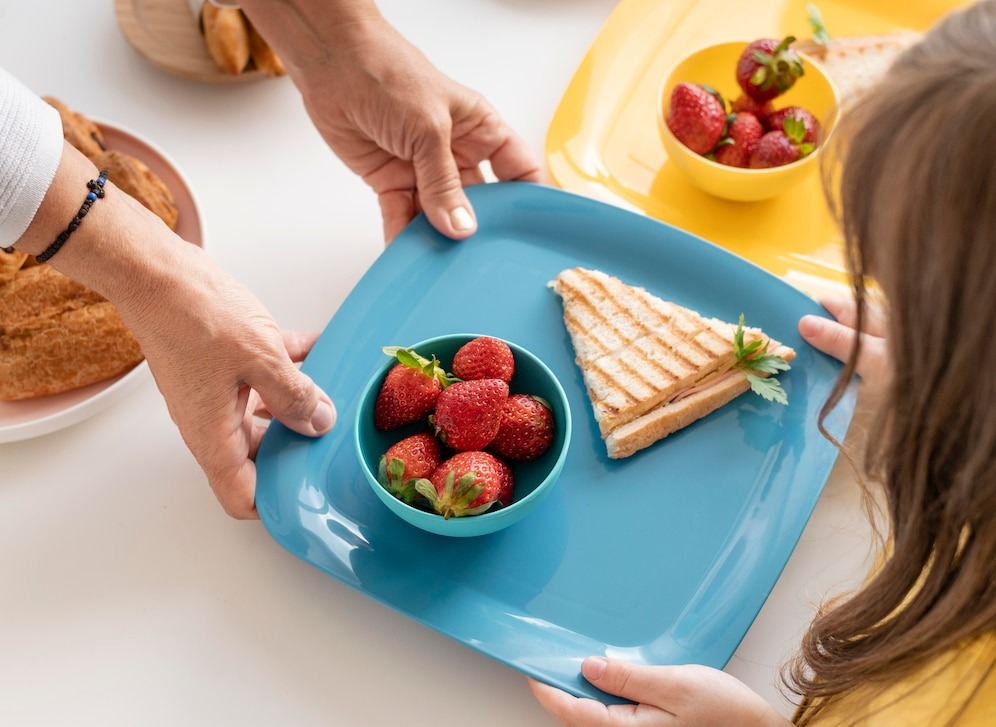
Instilling healthy eating habits is the one of the best gifts you could give your children. It’s a gift that can help them today and make them stronger tomorrow. Your child’s physical and mental development also depends on the nutrition they receive. It’s not just about what they want to eat, but also about what they need.
Little children are more interested in playing rather than eating, so developing healthy mealtime habits can be a challenge. It’s quicker to open a pack of chips or gobble down cookies instead of having a balanced meal. However, if these quick fixes become habits, it may lead them down a dangerous path of obesity, cavities, and other health issues.
As a parent or caregiver, teach kids the benefits of a balanced meal, but in a way they’ll remember. Kids remember what they enjoy, so incorporate some creativity and fun into their dietary routines. Here are six fun tips to ensure children receive essential nutrients, but in a playful and engaging manner.
Table of Contents
1. Storytelling With Food

Source: freepik.com
Children love a good story. Craft stories to turn healthy food into secret recipes for superpowers. For instance, you could remind your kids to have their apple cider vinegar supplements by treating them like magical potions. Explain how ACV gummies give them the power to fight off the bad bacteria lurking around in their tummies. You can get more information about how ACV fights bad gut bacteria at: numogummies.com.
Let your imagination run wild as you describe the adventures of Captain Cabbage and the Brave Broccoli. The only way to save the day is to be digested! Associating positive stories with healthy foods can make them more appealing and intriguing to kids. Create your own multiverse of nutrition, adding new characters as you add new fruits and vegetables to their meals. Engrossed in the stories, kids may finish their food faster as they’re playing a role in the plot.
2. Interactive Meal Prep
Encourage children to participate in meal preparation. Take them grocery shopping, and teach them how to pick fruits, veggies, and other healthy ingredients. Depending on their age, educate them on how to read food labels. Tell them that too much sugar, salt, and fat should be avoided as it may make them sick over time. Treat the fresh produce section like a treasure chest. Make it feel like the most special area in the store.
Even in the kitchen, make them your little helper as you wash, chop, and cook the food. This involvement not only piques their interest but also teaches them the different ways fruits and vegetables can be used. Organize cooking adventures so kids can experiment with simple recipes under supervision. Even if your child is not the next MasterChef, having an interest in culinary arts is a valuable life skill.
3. Colorful Plate Art
Transform their plate into a canvas by arranging foods of different colors. Create clown faces or animal shapes using cookie cutters and fun picks. Instead of artificially sweetened products, offer a fruit rainbow for dessert. Strawberries, oranges, pineapple, kiwi, blueberries, and grapes can make a healthy rainbow. This visual feast may be enough to entice children to explore and enjoy their meals.
The color doesn’t have to be restricted to their plates. Encourage kids to blend all those colors and create their own smoothie concoction. Provide them a range of produce to turn into delicious and nutritious drinks. This activity allows them to experiment while you get to bond with your kids, creating meals and memories.
4. Family Bonding
Mealtime should be a relaxed and enjoyable atmosphere where the family talks and laughs with each other. Share stories, play light-hearted games, or ask everyone to discuss their day. Remind them to appreciate the taste and smell of their food, instead of gobbling it down in a rush. These basics of mindful eating can make them grateful for the food they have, instead of taking it for granted.
It’s also beneficial to keep a no-screen policy at mealtimes. This lets children concentrate on their food instead of the television or tablet. Eating meals at the table, instead of on-the-go has been seen to reduce overeating and promote digestion. Rotating the menu and trying new recipes also makes dinner more exciting for the kids (as well as the adults). Keep in mind that kids have a short attention span, so try making mealtime more fun for them.
5. Food Adventures

Source: freepik.com
Incorporate the importance of a healthy diet through games and other activities. Blindfolded taste tests or guessing games with different fruits or vegetables can be a fun way to introduce new flavors. Get kids a toy kitchen set and let them pretend to be chefs or restaurant owners. Help them create menus with healthy options for their customers, be it family members or their stuffed toys.
You can give your child a hands-on activity by having your own veggie patch in your backyard. Include kids during planting and nurturing fruits, vegetables, and herbs. This experience teaches them about the origin of food and how much time it takes to grow plants. Moreover, it instills a sense of responsibility and pride in consuming what they’ve grown.
6. Lead by Example
Habits take time to stick, so don’t give up too soon. Re-introduce the same food in a different form. Make sure your pantry is stacked with healthy snacks, so your child knows what to eat when hunger strikes. Children imitate their parents. If they see you enjoying a banana instead of chocolate, they might just follow suit.
It’s also a good idea not to reward children with food, especially desserts. These seemingly benign donuts and ice cream can be dangerous. They can inculcate a habit where kids feel they need comfort food to be happy. Rather, work on associating food with energy and strength. This may be an uphill task, but with patience and creativity, it’s possible.
No matter how hard you try, peer pressure may make your children choose candy over carrot sticks. Instead of showing disappointment when they choose sweets, acknowledge and appreciate their healthy choices. Your goal should be to educate, not enforce. Set them off in the right direction as a child, and hopefully, it’ll become second nature as they grow older.







